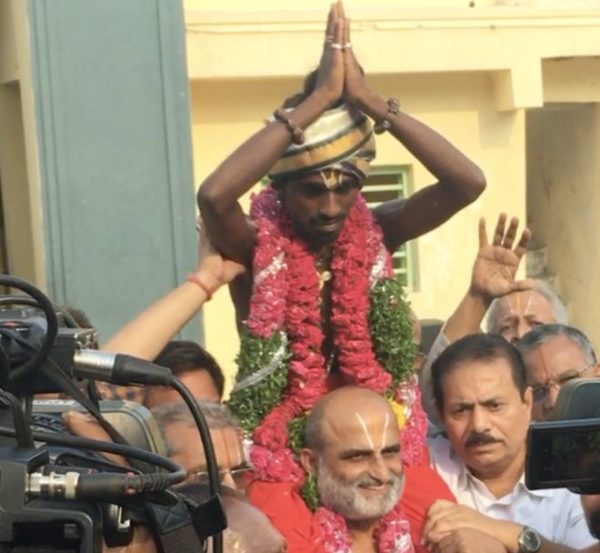A Hindu priest from a temple in the southern Indian city of Hyderabad made headlines for carrying a Dalit (formerly known as untouchable) man on his shoulders into the temple’s inner sanctum.
It has been seen as a dramatic move because Dalits have historically been denied entry into temples as they are considered “impure” by many conservative Hindus. Even today, most temples in India do not allow Dalits to enter.
“I wanted to show people that everyone is equal in the eyes of god,” the priest, CS Rangarajan, told BBC Telugu’s Balla Satish.
Dalits are among India’s most downtrodden citizens because of an unforgiving Hindu caste hierarchy that condemns them to the bottom of the heap. Despite laws to protect them, discrimination remains a daily reality for the country’s roughly 200 million Dalits.
Traditionally, they have been segregated from the upper castes and are not allowed to attend the same temples, schools or even drink from the same cups or wells. They do not get equal education and job opportunities, and are often victims of exploitation, abuse and violence.
Mr Rangarajan is the head priest at the popular Chilkur Balaji temple in Hyderabad. After entering the temple, Mr Rangarajan, and the Dalit youth, Aditya, (who only uses his first name) prayed and performed rituals together.
“There is a lot of discrimination against Dalits but this stems from society, not from religious scriptures,” Mr Aditya said. He described himself as a deeply religious man who had spent years studying Hindu texts and philosophical treatises.
Mr Rangarajan said he was inspired by a recent discussion he had attended on Dalit identity at a city university where he had told the students about a centuries-old legend in which a Dalit devotee was carried into a temple on the shoulders of a Hindu priest.
According to the legend, the devotee, who was named Thriuppan Alwar, was not permitted to enter the Srirangam temple, one of Hinduism’s holiest shrines, in the southern state of Tamil Nadu. So he would sit outside the temple and sing devotional songs through the day. But a sage who did not approve of this forced him to leave by hurling a stone at him – Alwar was bleeding as he ran away.
When the sage went back into the temple, the story goes, he discovered that the idol was also “bleeding”. Realising his mistake in denying the man entry, the sage is said to have carried Alwar into the temple on his shoulders. Today, Alwar is a revered saint.
When Dr Rangarajan narrated the story, he said some Dalit students had expressed scepticism and asked him outright if a Hindu priest would carry a Dalit on his shoulders in present day India. So he decided to do it himself.
“I hope others do the same – it doesn’t mean everyone should literally carry a Dalit man on their shoulders. But they must welcome Dalits into temples and to participate in rituals,” Mr Rangarajan said.
Mr Aditya also told the BBC that he hoped for change as he had grown up in a village where Dalits were not allowed into temples.
“Such inequality will hardly disappear overnight. But actions like this will certainly have a positive impact,” Vamsa Tilak, a social activist who fights for Dalit entry into temples, told BBC Telugu.
He said other priests who were present when Mr Rangarajan carried Mr Aditya into the temple also declared that they would do the same in the temples where they worked.
“It’s not that we want to be carried on their shoulders. What we want is kindness and generosity. We want to be a part of the community, Mr Tilak said.
But not everyone is as hopeful.
“Maybe this will lead to more Dalits entering temples but I doubt it – the caste system is an essential part of the Hindu faith,” said Sujatha Surepalli, a college professor and Dalit activist.
Her comments come amid rising tensions between Dalits and upper caste Hindus.
Lately, activists say that rising aspirations among young Dalits have improved their lives, but this has also increased violence against them by upper caste community members who are unable to accept this.



Leave a reply